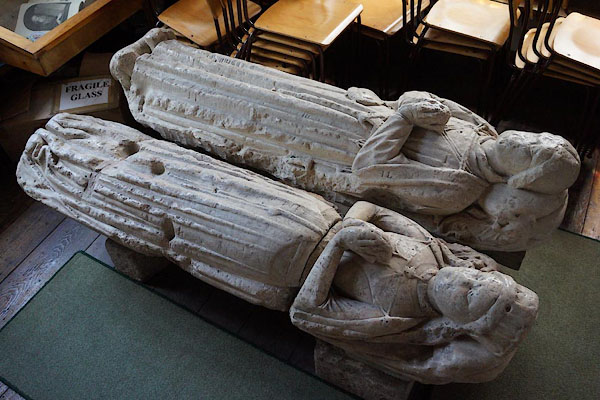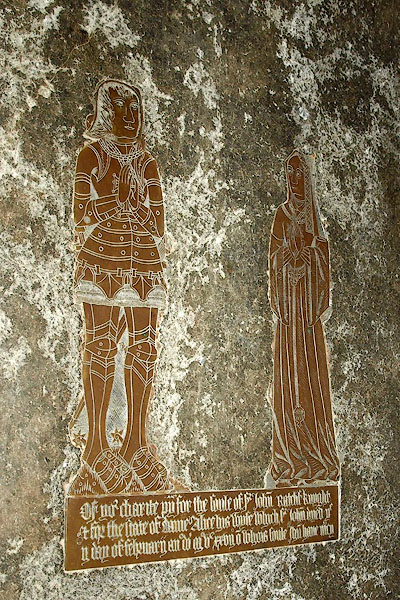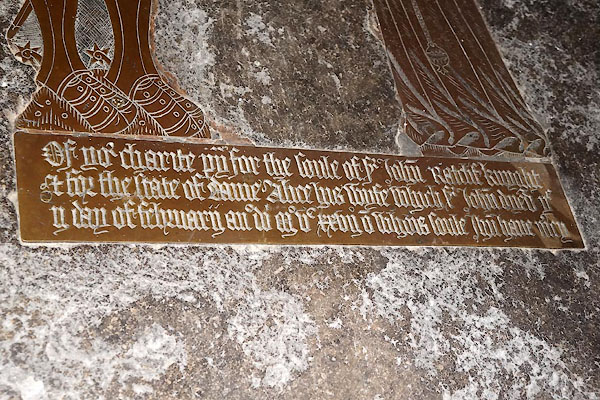




 St Kentigern, Great Crosthwaite
St Kentigern, Great Crosthwaite
CBA74.jpg Alabaster effigies, probably of Thomas Radcliffe and his wife, 1495.
(taken 9.7.2014)
item:- effigy; monumental brass
 goto source
goto sourceGentleman's Magazine 1849 part 1 p.374 "THE east end of the south aisle of the chancel, generally known as the Derwentwater aisle, is divided from the chancel by an arch whose span is considerably wider than that of the opposite arch on the north aisle. Here, for unnumbered generations, for the origin and antiquity of the family is lost in the obscurity of unrecorded times, the ashes of the Derwentwaters reposed until exhumed previous to the renovation of the church. "
"In this sanctuary also rested two of those attractive remnants of antiquity, their sculptured monumental figures, which erstwhile lay side by side upon enriched altar tombs long since destroyed; and in the same spot they are again replaced, to be, it is hoped, no more disturbed. The marble effigies are the oldest, and to secure them from further injury, as well as to gain additional accommodation for new sittings, they have been laid next to the south end of the altar rails, upon a deep slab of red sandstone placed upon the floor, and within an open screen-work of the same sort of stone. On the top lies a heavy slab of dark grey marble, and into it the sepulchral brass hereafter described is inlaid. The effigies which lie extended at full length are those of a knight and his lady, supposed to commemorate one of the Derwentwaters and his wife. Tradition however being altogether silent, and no relics or legend having been discovered that could throw light upon their history, all knowledge of the particular individuals whom such memorials were intended to honour would seem to be lost; though an antiquary familiar with the genealogical records of the northern counties, and versed in the history of the ancient periods of costume, might assign them as the effigies of Sir John de Derwentwater, the last of the name, and his wife, who lived in the reign of Henry IV. The male figure is habited in a long, high, loose, tunic or robe, with wide sleeves, secured round the waist by a belt, from which a pouch, or aulmoniere as it was called, hangs at the right side. The head is bare. The hair, formally parted on the forehead, is worn long behind, and an enriched collar is about the neck. The long, embroidered mantle of knighthood is secured on the shoulders by a band across the chest, and the hands are upraised upon the breast in that expressive attitude of humility and supplication which is so peculiarly affecting in the monumental effigies of other times."
"The lady's dress is a kirtle or close-bodied garment, low on the bosom, with long tight sleeves, and a long skirt. The head is surmounted by a sort of coronet, from underneath which a veil or hood, concealing the hair, flows down each side upon the shoulders. An ornamental collar and necklace are around the throat, from which a pendent jewel rests upon the bosom; and the waist is encircled by a girdle, attached to which is along cord, whose broken ends and tassels descend in front nearly to the feet. A long open mantle falls from the shoulders, where it is secured by a band across the bosom, fastened on each side to the mantle by a fermail or brooch, and the hands are likewsie joined in attitude of prayer. The heads repose on tasseled cushions once upheld by angels, and the knight's feet rest on the broken form of a hound, but what support the lady had for the feet has long since been worn away and destroyed. The countenances of both are defaced, and almost all the finer parts of the sculpture flattened and mutilated. the effigies seem originally to have been painted and gilt, the application of such polychromatic enrichment being still slightly perceptible, especially on the lady's collar."
"The other spulchral momento is a brass, laid down on a slab of dark grey Kendal marble. It is in tolerably perfect preservation, and its value is largely enhanced from the fact of its being one of the very few monumental"
 goto source
goto sourceGentleman's Magazine 1849 part 1 p.375 "brasses that remain in the churches of Cumberland - a county so singularly poor in such ancient enriched obituary memorials, that there are but four others to be met with. The brass therefore in this church, though not of the most beautiful period of the art, is nevertheless valuable not alone from its local rarity, but as one of the very few material relics of a family whose sway through many centuries so widely extended around this their narrow bed. The knight is sheathed in the complete armour of plate worn at the period of his decease; the head, face, and hands alone being uncovered. The hair is parted on the forehead, and falls in tresses behind. Round the neck and shoulders are ornamental chains, pendent from one of which a jewelled decoration rests upon the chest. The hands are raised in prayer; and on the heels are the spurs of knighthood. A dagger is slung behind the right side, and behind the left is a long straight cross-handled sword. On the head of the lady is that peculiar head-dress worn by females of distinction in the reigns of Henry VII. and Henry VIII. called a coif, which totally conceals the hair. The embroidered neck of an under-garment encircles the throat; over this is a high and close-bodied gown, falling in long ample folds from the waist, where it is secured by a girdle clasped in front by an ornament composed of three roses, from which, suspended by a long chain reaching nearly to the feet, hangs another ornament of a circular form. The arms of the dress are tight, and finished at the wrists with ruffles, and over them is drawn the wide, loose, hanging sleeves so common at the time. A wrought chain is on the shoulders, and around the neck is another, fastened to an ornament on the bosom similar to that worn by the knight; and, like those of the male figure, the hands are also raised in a supplicatory attitude. The legend engraven on brass at the foot of the figures runs thus:"
""Of your charitie pray for the soule of Sir John Ratcliffe, knight, and for the state of Dame Alice his wife, which Sir John died the 2nd of Februere, A.D.1527, on whose soule Jesu have mercie.""
"From this inscription it would appear that Lady Ratcliffe was not deceased at the time when the brass was laid down; and most probably not only this graven record, but likewise that other mark of hereditary honour - the escutcheon in stained glass, which formerly was seen in the great east window - were set up by her direction in Henry the Eighth's reign. At the knight's head is a shield bearing, Argent, a bend engrailed sable, the armorail coat of the Ratcliffes; and at his feet another, charged with, Or, two lions passant in pale gules, the arms of Dame Alice. The shield at the head of Dame Alice carries her paternal coat; and on the shield at her feet are the Ratcliffe arms repeated, with the additional charge of a rose in the sinister corner of the chief, for a difference of houses."
"The knight to whose memory this brass was laid down, and who was the last person of importance of his family that was interred in this church, reckoned in his lineage a long line of illustrious ancestors. He was maternally descended from the Derwentwaters, being the great-grandson of Margaret de Derwentwater, the daughter and sole heiress of Sir John de Derwentwater, who in Henry the Fifth's reign married Sir Nicholas Ratcliffe of Dilston, a Northumbrian knight; and from which union sprung the Ratcliffes of Dilston and Derwentwater. His immediate progenitor was Sir Edward Ratcliffe, of whom he was the second or seventh son; and he is supposed to have held the Derwentwater estate in this vicinity by settlement or devise. He was a person of much consideration in his day, and was ofttimes selected by his successive sovereigns Henry the Seventh and Henry the Eighth to fill the then more actively important and warlike office of sheriff of Cumberland, which at that time was incessantly harassed by the predatory inroads of the bordering Scots, his last year of office being scarcely completed in 1527, when he died. He likewise several times held the King's commission to treat, on peace and other matters affecting the realm, with his gallant but restless neighbours. He was the last of his family who served any office of note in Cumberland, as from thenceforward"
 goto source
goto sourceGentleman's Magazine 1849 part 1 p.376 "The Ratcliffes were connected with this county only by their landed possessions and their name, afterwards ennobled as Earls of Derwentwater, to which title circumstances in a subsequent age gave a romantic interest."
"By his wife Dame Alice he had not any issue; and, dying a childless man, the estates of the Derwentwaters reverted to his elder brother, Sir Cuthbert Ratcliffe, of Dilston; as it appears from a survey made in the thirty-fifth of Henry the Eighth of knight's fees in Cumberland, these estates were held by Sir Cuthbert of the King by the service of two knights' fees and the rendition of various other obligations incident to the feudal régime. In that family they continued until, for conspiring, in the words of one of the most spirited Jacobite songs of the period, to bring "the auld Stewarts back again," they were forfeited to the Crown, on the attainder and execution in 1716 of the last Earl of Derwentwater, the traditionary stories of whose youth, gallantry, and misfortunes have thrown so magic an interest over the neighbourhood around."
"..."

BRA46.jpg Monumental brass, Sir John Ratcliffe, 1527 and his wife.
(taken 9.7.2009)

CDR22.jpg Monumental brass, Sir John Ratcliffe, 1527 and his wife.
(taken 14.8.2015)
